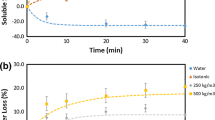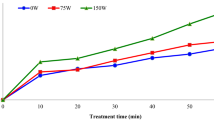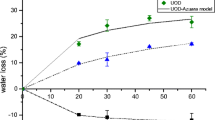Abstract
This study investigates the effects of different process parameters (sugar dose, sugar size, and ultrasonic treatment time) on the solid osmotic dehydration (SOD) process of jasmine flowers and the physiochemical characteristics of syrup. The kinetics of moisture loss, solute gain, and effective diffusivity during SOD were predicted by fitting the experimental data with the Azuara model, Weibull model, and Fick second law model. The results showed that the high regression coefficient (R2 > 0.9) and low χ2 value represented the suitability of the Azuara model for predicting equilibrium water loss and solid gain and the Weibull model for predicting both moisture and solute fraction in jasmine under different process parameters during SOD. A relatively high sugar dose (120% w/w, fresh jasmine flower basis) and moderate sugar size (6–20 mesh) enhanced the moisture loss and solute uptake during SOD and produced more syrup. Furthermore, the high sugar dose (120% w/w) and small sugar size (40 mesh) enhanced the diffusion of polyphenols and flavonoids in jasmine to syrup. The mass transfer rate and syrup yield were increased, and more polyphenols, flavonoids, and antioxidant components were diffused to the syrup after applying the ultrasonic waves during SOD. Most flavour compounds of jasmine were effectively extracted by SOD under different process parameters, and alcohols (more than 68%) are the main flavour components of syrups, but the amount of major volatile compounds extracted was not affected by SOD process parameters.




Similar content being viewed by others
Data Availability
The datasets generated during the current study are available from the corresponding author upon reasonable request.
References
Alarcón, Á. L., Orjuela, A., Narváez, P. C., & Camacho, E. C. (2020). Thermal and rheological properties of juices and syrups during non-centrifugal sugar cane (jaggery) production. Food and Bioproducts Processing, 121, 76–90.
Alolga, R. N., Osae, R., Essilfie, G., Saalia, F. K., Akaba, S., & Chikari, F. (2021). Sonication, osmosonication and vacuum-assisted osmosonication pretreatment of Ghanaian garlic slices: Effect on physicochemical properties and quality characteristics. Food Chemistry, 343, 128535.
Amami, E., Khezami, L., Vorobiev, E., & Kechaou, N. (2008). Effect of pulsed electric field and osmotic dehydration pretreatment on the convective drying of carrot tissue. Drying Technology, 26(2), 231–238.
An, K., Tang, D., Wu, J., Fu, M., Wen, J., Xiao, G., & Xu, Y. (2019). Comparison of pulsed vacuum and ultrasound osmotic dehydration on drying of Chinese ginger (Zingiber officinale Roscoe): Drying characteristics antioxidant capacity and volatile profiles. Food Science & Nutrition, 7(8), 2537–2545.
Azuara, E., Cortés, R., Garcia, H. S., & Beristain, C. I. (2010). Kinetic model for osmotic dehydration and its relationship with Fick’s second law. International Journal of Food Science & Technology, 27(4), 409–418.
Blankenship, J. L., Garrett, G. S., Khan, N. A., De-Regil, L. M., Spohrer, R., & Gorstein, J. (2018). Effect of iodized salt on organoleptic properties of processed foods: A systematic review. Journal of Food Science and Technology, 55(9), 3341–3352.
Cheng, N., Du, B., Wang, Y., Gao, H., Cao, W., Zheng, J., & Feng, F. (2014). Antioxidant properties of jujube honey and its protective effects against chronic alcohol-induced liver damage in mice. Food & Function, 5(5), 900–908.
Ciurzyńska, A., Kowalska, H., Czajkowska, K., & Lenart, A. (2016). Osmotic dehydration in production of sustainable and healthy food. Trends in Food Science & Technology, 50, 186–192.
Crank, J. (1975). The mathematics of diffusion (2nd ed.). WSEAS Transactions on Systems and Control, 8(3), 625–626.
Dash, K. K., & Balasubramaniam, V. M. (2018). Effect of high pressure on mass transfer kinetics of granny smith apple. Drying Technology, 36(13), 1631–1641.
Dash, K. K., Balasubramaniam, V. M., & Kamat, S. (2019). High pressure assisted osmotic dehydrated ginger slices. Journal of Food Engineering, 247, 19–29.
Dewanto, V., Wu, X. Z., Adom, K. K., & Liu, R. H. (2002). Thermal processing enhances the nutritional value of tomatoes by increasing total antioxidant activity. Journal of Agricultural and Food Chemistry, 50(10), 3010–3014.
Etemadi, A., Alizadeh, R., & Sirousazar, M. (2020). The influence of natural basil seed gum coats on the kinetics of osmotic dehydration of apple rings. Food and Bioprocess Technology, 13(9), 1505–1515.
Feng, Y., Yu, X., Yagoub, A. E. A., Xu, B., Wu, B., Zhang, L., & Zhou, C. (2019). Vacuum pretreatment coupled to ultrasound assisted osmotic dehydration as a novel method for garlic slices dehydration. Ultrasonics Sonochemistry, 50, 363–372.
Fernández, P. R., Lovera, N., & Ramallo, L. A. (2020). Sucrose syrup reuse during one‐and multi‐stage osmotic dehydration of pineapple. Journal of Food Process Engineering, 43(6), e13399.
Geow, C. H., Tan, M. C., Yeap, S. P., & Chin, N. L. (2020). Kinetic mechanism of hazelnut oil extraction with ultrasound-assisted osmotic dehydration pretreatment. Food and Bioprocess Technology, 14(1), 187–194.
Goslinski, M., Nowak, D., & Szwengiel, A. (2021). Multidimensional comparative analysis of bioactive phenolic compounds of honeys of various origin. Antioxidants (basel), 10(4), 530.
Issa, M. Y., Mohsen, E., Younis, I. Y., Nofal, E. S., & Farag, M. A. (2020). Volatiles distribution in jasmine flowers taxa grown in Egypt and its commercial products as analyzed via solid-phase microextraction (SPME) coupled to chemometrics. Industrial Crops and Products, 144, 112002.
Koprivica, G. B., Pezo, L. L., Curcic, B. L., Levic, L. B., & Suput, D. Z. (2014). Optimization of osmotic dehydration of apples in sugar beet molasses. Journal of Food Processing and Preservation, 38(4), 1705–1715.
Kroehnke, J., Szadzinska, J., Radziejewska-Kubzdela, E., Bieganska-Marecik, R., Musielak, G., & Mierzwa, D. (2021). Osmotic dehydration and convective drying of kiwifruit (Actinidia deliciosa) - The influence of ultrasound on process kinetics and product quality. Ultrasonics Sonochemistry, 71, 105377.
Landim, A. P. M., Barbosa, M. I. M. J., & Júnior, J. L. B. (2016). Influence of osmotic dehydration on bioactive compounds, antioxidant capacity color and texture of fruits and vegetables: A review. Ciência Rural, 46(10), 1714–1722.
Lee, J. S., Ramalingam, S., Jo, I. G., Kwon, Y. S., Bahuguna, A., Oh, Y. S., Kwon, O. J., & Kim, M. (2018). Comparative study of the physicochemical, nutritional, and antioxidant properties of some commercial refined and non-centrifugal sugars. Food Research International, 109, 614–625.
Lemus-Mondaca, R., Zambra, C., Marín, F., Pérez-Won, M., & Tabilo-Munizaga, G. (2018). Mass transfer kinetic and quality changes during high-pressure impregnation (HPI) of jumbo squid (Dosidicus gigas) slices. Food and Bioprocess Technology, 11(8), 1516–1526.
Letaief, T., Mejri, J., Ressureição, S., Abderrabba, M., & Costa, R. (2021). Extraction of Ziziphus lotus fruit syrups: Effect of enzymatic extraction and temperature on their rheological and chemical properties. International Agrophysics, 35(1), 31–40.
Liu, Z.-L., Staniszewska, I., Zielinska, D., Zhou, Y.-H., Nowak, K. W., Xiao, H.-W., Pan, Z., & Zielinska, M. (2020). Combined hot air and microwave-vacuum drying of cranberries: Effects of pretreatments and pulsed vacuum osmotic dehydration on drying kinetics and physicochemical properties. Food and Bioprocess Technology, 13(10), 1848–1856.
Luo, W., Tappi, S., Wang, C., Yu, Y., Zhu, S., Dalla Rosa, M., & Rocculi, P. (2018a). Effect of high hydrostatic pressure (HHP) on the antioxidant and volatile properties of candied wumei fruit (Prunus mume) during osmotic dehydration. Food and Bioprocess Technology, 12(1), 98–109.
Luo, W., Tappi, S., Wang, C., Yu, Y., Zhu, S., & Rocculi, P. (2018b). Study of the effect of high hydrostatic pressure (HHP) on the osmotic dehydration mechanism and kinetics of wumei fruit (Prunus mume). Food and Bioprocess Technology, 11(11), 2044–2054.
Milani, E., & Koocheki, A. (2011). The effects of date syrup and guar gum on physical, rheological and sensory properties of low fat frozen yoghurt dessert. International Journal of Dairy Technology, 64(1), 121–129.
Mohammed, F., Warland, J., & Guillaume, D. (2021). A comprehensive review on analytical techniques to detect adulteration of maple syrup. Microchemical Journal, 164, 105969.
Nowacka, M., Dadan, M., & Tylewicz, U. (2021). Current applications of ultrasound in fruit and vegetables osmotic dehydration processes. Applied Sciences, 11(3), 1269.
Nowacka, M., Tylewicz, U., Tappi, S., Siroli, L., Lanciotti, R., Romani, S., & Witrowa-Rajchert, D. (2018). Ultrasound assisted osmotic dehydration of organic cranberries (Vaccinium oxycoccus): Study on quality parameters evolution during storage. Food Control, 93, 40–47.
Pei, F., Xiao, K., Chen, L., Yang, W., Zhao, L., Fang, Y., Ma, N., Mariga, A. M., & Hu, Q. (2019). Mass transfer characteristics during ultrasound-assisted osmotic dehydration of button mushroom (Agaricus bisporus). Journal of Food Science and Technology, 56(4), 2213–2223.
Prithani, R., & Dash, K. K. (2020). Mass transfer modelling in ultrasound assisted osmotic dehydration of kiwi fruit. Innovative Food Science & Emerging Technologies, 64, 102407.
Ramalingam, S., Dhatchanamoorthi, I., Arumugam, A., Bahuguna, A., Krishnamoorthy, M., Lee, J. S., Devarajan, N., & Kim, M. (2021). Functional nutritional antinutritional and microbial assessment of novel fermented sugar syrup fortified with pre-mature fruits of Totapuri mango and star gooseberry. LWT-Food Science and Technology, 136, 110276.
Ramya, V., & Jain, N. K. (2017). A review on osmotic dehydration of fruits and vegetables: An integrated approach. Journal of Food Process Engineering, 40(3), e12440.
Rodrigues, S., Oliveira, F. I. P., Gallao, M. I., & Fernandes, F. A. N. (2009). Effect of immersion time in osmosis and ultrasound on papaya cell structure during dehydration. Drying Technology, 27(2), 220–225.
Rodriguez-Flores, M. S., Falcao, S. I., Escuredo, O., Seijo, M. C., & Vilas-Boas, M. (2021). Description of the volatile fraction of Erica honey from the northwest of the Iberian Peninsula. Food Chemistryt, 336, 127758.
Semenoglou, I., Dimopoulos, G., Tsironi, T., & Taoukis, P. (2020). Mathematical modelling of the effect of solution concentration and the combined application of pulsed electric fields on mass transfer during osmotic dehydration of sea bass fillets. Food and Bioproducts Processing, 121, 186–192.
Sharma, M., & Dash, K. K. (2019). Effect of ultrasonic vacuum pretreatment on mass transfer kinetics during osmotic dehydration of black jamun fruit. Ultrasonics Sonochemistry, 58, 104693.
Song, C., Ma, X., Li, Z., Wu, T., Raghavan, G. V., & Chen, H. (2020). Mass transfer during osmotic dehydration and its effect on anthocyanin retention of microwave vacuum-dried blackberries. Journal of the Science of Food and Agriculture, 100(1), 102–109.
Stojanovic, J., & Silva, J. L. (2007). Influence of osmotic concentration, continuous high frequency ultrasound and dehydration on antioxidants, colour and chemical properties of rabbiteye blueberries. Food Chemistry., 101(3), 898–906.
Tayyab Rashid M, Ahmed Jatoi M, Safdar B, Wali A, Muhammad Aadil R, Sarpong F & Ma H (2020) Modeling the drying of ultrasound and glucose pretreated sweet potatoes: The impact on phytochemical and functional groups. Ultrason Sonochem, 68, 105226.
Tsitlakidou, P., Van Loey, A., Methven, L., & Elmore, J. S. (2019). Effect of sugar reduction on flavour release and sensory perception in an orange juice soft drink model. Food Chemistry, 284, 125–132.
Turkiewicz, I. P., Wojdyło, A., Tkacz, K., Lech, K., & Nowicka, P. (2020). Osmotic dehydration as a pretreatment modulating the physicochemical and biological properties of the Japanese quince fruit dried by the convective and vacuum-microwave method. Food and Bioprocess Technology, 13(10), 1801–1816.
Urbanus, B. L., Schmidt, S. J., & Lee, S.-Y. (2014). Sensory differences between product matrices made with beet and cane sugar sources. Journal of Food Science, 79(11), S2354–S2361.
Wang, J., Teng, J., Wei, B., Huang, L., & Xia, N. (2021). Effects of different osmosis methods on the dehydration efficiency and quality of mango fruits. Food Science, 42(1), 149–156.
Wang, Y., Li, D., Cheng, N., Gao, H., Xue, X., Cao, W., & Sun, L. (2015). Antioxidant and hepatoprotective activity of vitex honey against paracetamol induced liver damage in mice. Food & Functio, 6(7), 2339–2349.
Zúñiga, R. N., & Pedreschi, F. (2011). Study of the pseudo-equilibrium during osmotic dehydration of apples and its effect on the estimation of water and sucrose effective diffusivity coefficients. Food and Bioprocess Technology, 5(7), 2717–2727.
Funding
This work was supported by the Research Programme of Agriculture Research System of China (CARS-170502).
Author information
Authors and Affiliations
Corresponding authors
Ethics declarations
Competing Interests
The authors declare no competing interests.
Additional information
Publisher's Note
Springer Nature remains neutral with regard to jurisdictional claims in published maps and institutional affiliations.
Supplementary Information
Below is the link to the electronic supplementary material.
Rights and permissions
About this article
Cite this article
Zhang, Z., Yu, J., Cheng, P. et al. Effect of Different Process Parameters and Ultrasonic Treatment During Solid Osmotic Dehydration of Jasmine for Extraction of Flavoured Syrup on the Mass Transfer Kinetics and Quality Attributes. Food Bioprocess Technol 15, 1055–1072 (2022). https://doi.org/10.1007/s11947-022-02787-3
Received:
Accepted:
Published:
Issue Date:
DOI: https://doi.org/10.1007/s11947-022-02787-3




